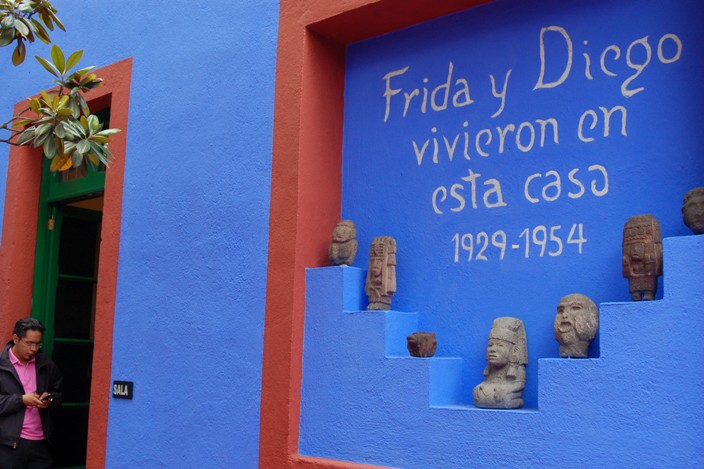(México City) — In the patio of a big house in the Town of Coyoacan, in the south side of Mexico City, where many years ago the Mexican painter Frida Kahlo would walk with her peculiar and long dresses, a lively concert of natural sounds —melodic bird calls, the waterfall of a fountain, the strumming of a guitar— blend into one single harmony, creating a soft and tranquil atmosphere.
The exuberant vegetation of the garden impresses with its varied range, alternating with the vibrant paint colors of walls, floors, and other surfaces. Colors all alive, evoking the brilliance and intensity of those captured by Frida on the canvases, where she leaped from the privacy of her daily pain to the worldwide immortality of her art.
Relacionado → Mural in Downtown Phoenix alley brings artists, social issues together
The Blue House —as the house is called— is a century-old cultural magnet of charming, artistic, and morbid appeal that draws people from all over the world to its famous location. There Frida was born and died; Frida the artist was inspired and painted; Frida the legend unfolded.
The Blue House is the —almost mythical— place where the clock of Frida’s life began and where it also stopped. Today it signifies not only the dwelling where the artist lived her brief, painful and tempestuous life, but also a sanctuary in which art flows from nature itself, as well as from the pictorial expression —in many ways alive— of the woman who dwelt in it. The character, the artist, the human being that Frida was, captured in such a way a unique artistic sentiment that, though not easy to explain and articulate, unleashed an interest which in turn founded the culture and mystique of its fascination. A seduction that attracts thousands of people today from diverse parts of the world to this house.
Whether it be in the tall walls painted in an iridescent blue that impregnates the vision with boldness, whether through the double French doors from where Frida’s eyes entered the garden, or by the nooks where her memories appear and hide, visitors possessed by a, sometimes obsessive Fridamania, try to find existential drafts that would paint for them a Frida —half reality, half fantasy—to conceive her, to know her, to understand her, and to appreciate her. With their sight, visitors comb the vestiges of the artist’s privacy: there are her paintings, her personal diary, her typical dresses, objects that give testimony of her talent, and others that give away her prolonged suffering.
Both her artistic creation and pain —Frida creator of art, Frida prostrated to pain— express silently and discreetly the plastic dimension of a woman in the same way that emanates her affliction. Easels, paintbrushes, and artworks struggle and collide against the plaster-cast corset, the wheelchair, the prosthesis of her leg.
Step by step, thousands of people go round the old Blue House and its big garden, that unlike the lifeless volcanic stone of the dwelling’s structure, it incessantly renews with new flowers and rookie birds. The voices of children visitors rejuvenate the old structure and replace it with their contemporary echoes the lost resonance of the voices that in the past inhabited this house.
The stone of the house quiets, the water of the fountain laughs; the ancient pre-Columbian idol contemplates with indifference, the new flower emerges with satisfaction; the bars of the balconies lock in, and the greenness of the plants liberate. On the whole, all and every one of the elements of the Blue House encloses —in a circumference of attraction and awe— the revealed truth of an artist that died to become immortalized. Her life, just like the volcanic stone of this big house, does not become renewed; her art, on the other hand, recreates and grows, like the trees of her garden. The Blue House is not magic; it is art. Frida is not a ghost, she is an artistic reality.
Watched over with annoying distrust, Frida’s belongings —and those of her husband, the muralist Diego Rivera— allow visitors to glance at the sometimes euphoric, sometimes unfortunate, world of a woman to whom the accidental conditions of her life and the subsequent physical pain, lighted up a creative flame that stirred up the fire of art. Wounded in her overwhelmed body, she intensified the paintbrush to yell out her affliction to the world from the privacy of a house that today is exposed to the entire world.
Frida’s intimate pain, reflected in her incomparable artworks, yelled out from her bedroom, jumped out from the balcony of her window, came out of the Blue House, flung into the streets, dared to travel across cities, to cross oceans, and to conquer countries. Pain prostrated her; she prostrated pain with her art.
Through the big, tall and green front door where they came in, visitors leave the Blue House of Frida Kahlo. On the sidewalk made of old paving stone, the same intense blue color that welcomed them bids them farewell. In another time, Frida herself would walk through this same big tall door, and on this same street. However, today Frida’s art enters through more spacious doors, travels across wide streets, and lodges in more luxurious and great galleries, far away from her native Coyoacán.
In this metaphoric sense, Frida walks again and on paths she never dreamed of. This, her great success, is no accident. Invulnerable and by the hand of her art, Frida amazes the world, triumphs compellingly, and she does it without any pain.
© 2015 - 2024, Eduardo Barraza. All rights reserved.





